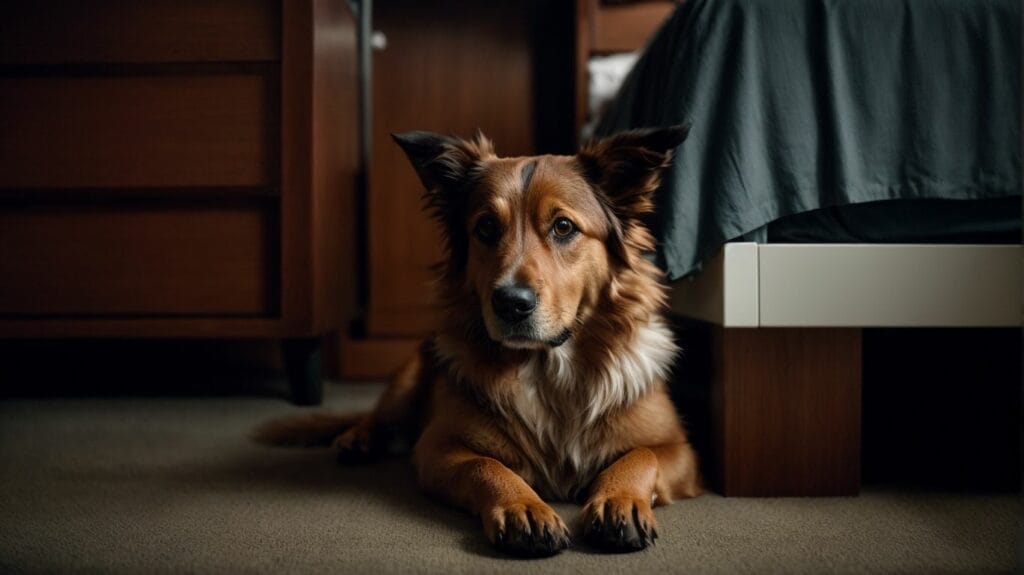Understanding Canine Fear: Why Dogs Are Scared of Thunder?
Thunderstorms can be a source of excitement or even exhilaration for some people, but for many dogs, they can trigger intense fear and anxiety. This common fear, known as thunder phobia, can have a significant impact on a dog’s well-being and behavior. But why are dogs so scared of thunder?
Thunder phobia is a specific phobia characterized by an extreme and irrational fear of thunderstorms. Dogs with this phobia can display a range of signs and symptoms when exposed to thunderstorms. Some of the common signs include shaking and trembling, excessive panting and drooling, seeking shelter or hiding, destructive behavior, and barking or howling.
There are several potential causes of thunder phobia in dogs. One of the main reasons is noise sensitivity. Dogs have more sensitive hearing than humans, and the loud bangs and rumbles of thunder can be overwhelming for them. Traumatic experiences, such as being caught in a severe thunderstorm or being injured during one, can also contribute to the development of thunder phobia. A lack of exposure to loud noises during the early socialization period can make dogs more prone to fear and anxiety when encountering thunderstorms.
If your dog is scared of thunder, there are several approaches you can take to help them cope. Creating a safe space, such as a designated area with familiar and comforting items, can provide a sense of security. Seeking professional help from a veterinarian or a certified dog behaviorist is also recommended, as they can provide guidance and personalized strategies for managing your dog’s fear. Providing distractions, such as interactive toys or soothing music, can help to redirect your dog’s focus during a thunderstorm.
Training techniques, such as desensitization and counterconditioning, can be effective in helping dogs overcome their fear of thunder. These techniques involve gradually exposing the dog to the sound of thunder at a low volume and pairing it with positive experiences to create a new positive association. Distraction techniques, such as engaging in training or play activities, can also help redirect your dog’s attention during thunderstorms. In some cases, medication options may be recommended by a veterinarian to help manage severe anxiety.
Prevention is also key in managing thunder phobia. Early socialization and exposure to various noises, including thunder-like sounds, during puppyhood, can help dogs develop resilience and reduce the likelihood of developing thunder phobia later in life. Positive reinforcement-based training methods can also help build your dog’s confidence and provide them with the skills to cope with stressful situations. Calming techniques, such as utilizing pressure wraps or pheromone-based calming products, can also help alleviate anxiety.
By understanding why dogs are scared of thunder and taking proactive steps to help them, you can assist in reducing their fear and improving their overall well-being. With patience, love, and the right strategies, you can help your furry friend feel safer and more secure during thunderstorms.
Key takeaway:
- Understanding Canine Fear: Dogs have an instinct to be fearful of loud noises like thunder. This fear can cause various signs and symptoms, such as shaking, hiding, and destructive behavior.
- Causes of Thunder Phobia in Dogs: Noise sensitivity, traumatic experiences, and lack of exposure to loud noises can contribute to dogs developing a fear of thunder.
- Helping Dogs Scared of Thunder: Creating a safe space, seeking professional help, and providing distractions and comfort are effective ways to support dogs with thunder phobia. Training techniques like desensitization and counterconditioning can also be beneficial.
Understanding Canine Fear: Why Dogs Are Scared of Thunder?
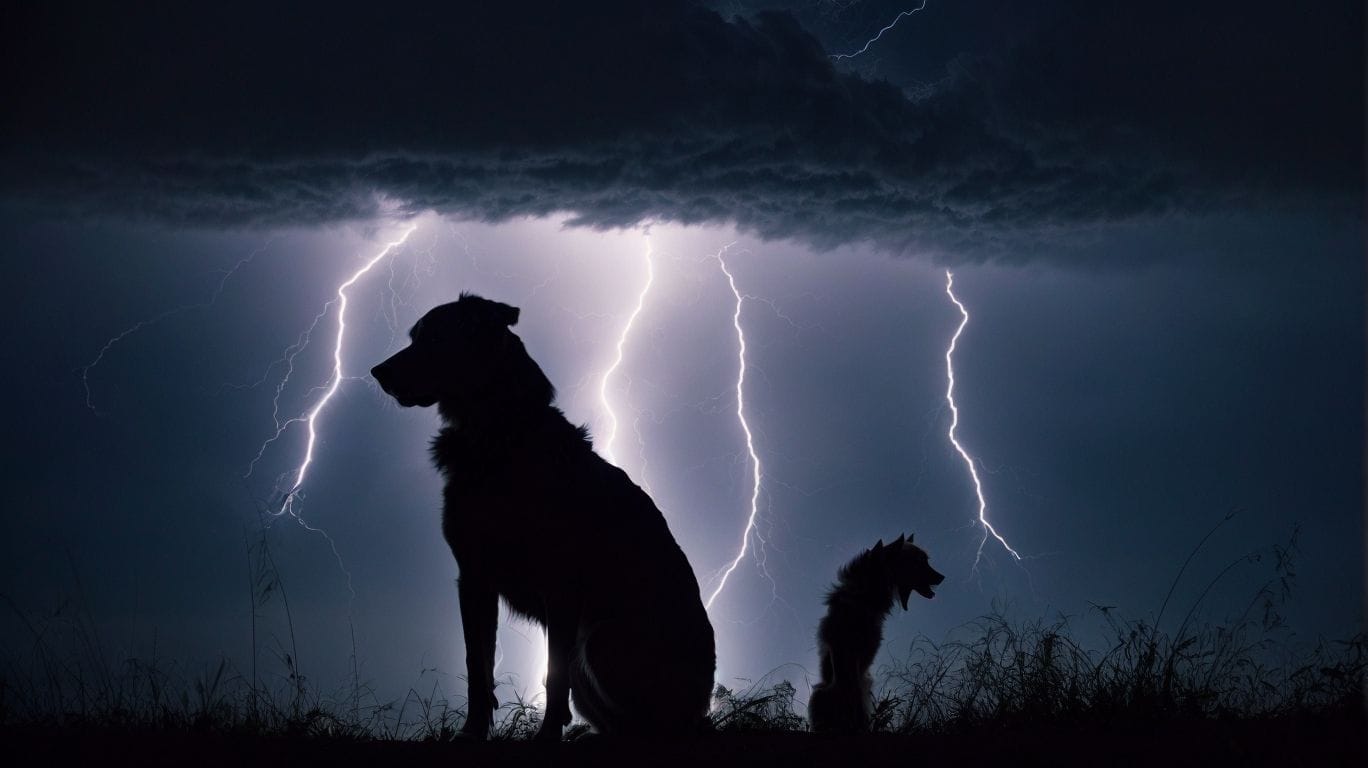
Photo Credits: Petnarnia.Com by Ronald Roberts
Dogs can experience fear and anxiety during thunderstorms. Understanding why dogs are scared of thunder can help pet owners alleviate their distress. The loud noise, vibrations, and changes in atmospheric pressure during a storm can be overwhelming for dogs. The unpredictable nature of thunder may startle them. Some dogs may have had negative experiences with thunder in the past, further contributing to their fear. Owners can help their dogs by creating a safe and comforting environment, using calming techniques like music or pheromone diffusers, and providing distractions. Professional help should be sought if the fear becomes severe or starts to interfere with the dog’s daily life.
Canine fear, particularly the fear of thunder, can be a common experience for dogs. Understanding why dogs are scared of thunder is crucial for pet owners to address their dogs’ distress effectively. The loud noise, vibrations, and changes in atmospheric pressure that occur during thunderstorms can easily overwhelm dogs. Moreover, the unpredictability of thunder may startle them even more. It is important to note that some dogs may have had negative encounters with thunder in the past, intensifying their fear. However, pet owners can play an active role in helping their dogs cope with thunder-related anxiety. Creating a secure and reassuring environment, utilizing calming techniques such as music or pheromone diffusers, and providing distractions are effective strategies for supporting dogs during thunderstorms. Nonetheless, if the fear becomes severe or significantly interferes with the dog’s daily life, seeking professional assistance is highly recommended.
What is Thunder Phobia in Dogs?
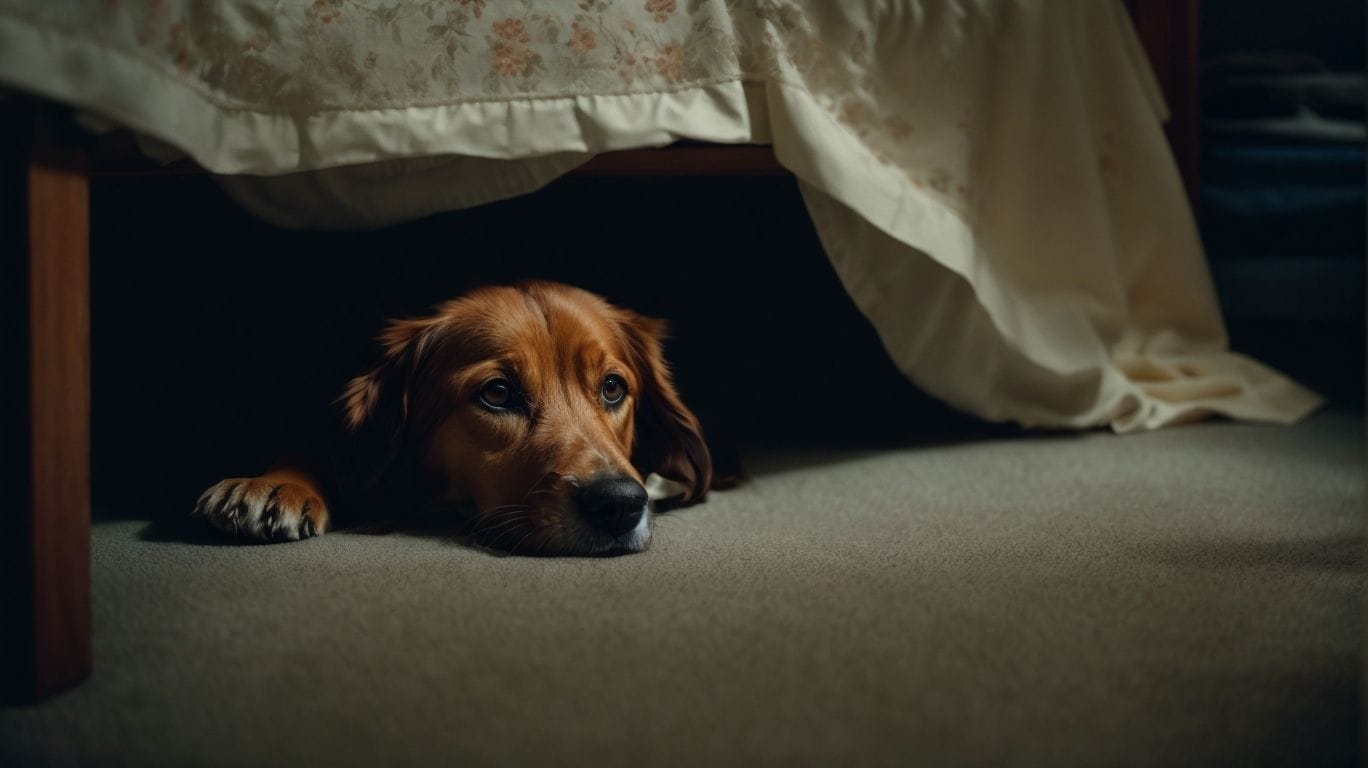
Photo Credits: Petnarnia.Com by Billy Rivera
Thunder phobia in dogs, also known as astraphobia or fear of thunderstorms, is a common behavioral issue characterized by intense fear or anxiety. Dogs experiencing thunder phobia may exhibit various signs of distress, including trembling, panting, hiding, or seeking comfort from their owners. The exact cause of this phobia is unknown, but it is believed to be a combination of loud noises, changes in atmospheric pressure, and electromagnetic static. To manage thunder phobia effectively, it is recommended to create a safe space for your dog to retreat to, employ desensitization techniques, and consider seeking guidance from a professional dog behaviorist if necessary.
Let me share a true story with you about my friend’s dog, Buddy, who suffered from a thunder phobia. Whenever a storm approached, Buddy would seek refuge under the bed, visibly shaking with fear. To help Buddy cope, my friend implemented various strategies, including creating a cozy den-like space accompanied by calming music and using anxiety wraps. Through patience and consistent support, Buddy gradually began to feel more secure during storms, and his fear of thunder diminished over time. Now, he can even peacefully observe the lightning from the window without feeling anxious. It’s truly remarkable how love and understanding can assist our beloved furry friends in conquering their fears.
Common Signs and Symptoms of Thunder Phobia
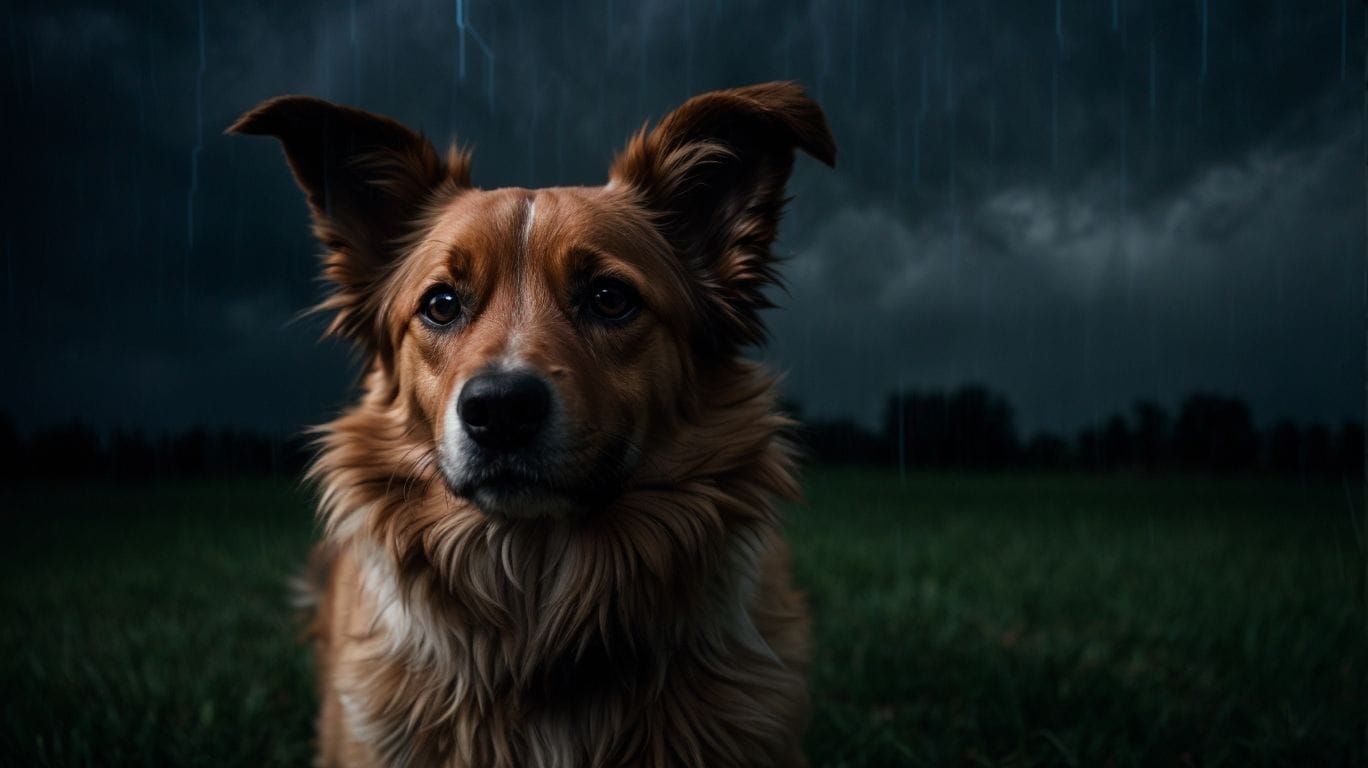
Photo Credits: Petnarnia.Com by Ronald Rivera
Does your furry friend tremble and cringe at the sound of thunder? In this section, we’ll unveil the common signs and symptoms of thunder phobia in dogs. From shaking and trembling to excessive panting and drooling, we’ll explore the behaviors that indicate their fear. We’ll also delve into their tendencies to hide, exhibit destructive behavior, and unleash those howling barks. Get ready to uncover the telltale signs of thunder phobia in our beloved canine companions!
1. Shaking and Trembling
Shaking and trembling are common signs of thunder phobia in dogs. When a storm approaches, dogs with thunder phobia may experience intense fear and anxiety, leading to physical manifestations such as shaking and trembling. This behavior occurs because dogs perceive the loud noises and vibrations associated with thunder as a threat. During these episodes, it is important to provide a safe space for the dog to minimize stress. Seeking professional help, using distractions and comfort, and employing training techniques like desensitization and counterconditioning can also help manage their fear. Early socialization and exposure, positive reinforcement training, and calming techniques are effective in preventing thunder phobia in dogs.
2. Excessive Panting and Drooling
Excessive panting and drooling are common signs of thunder phobia in dogs. When dogs are scared of thunder, their anxiety can trigger physiological responses such as rapid breathing and excessive saliva production. Some dogs may also pace, whine, or cling to their owners during a thunderstorm. To help a dog scared of thunder, create a safe space where they can seek refuge, provide distractions and comfort, and consider seeking professional help for behavioral training techniques. Preventative measures like early socialization, positive reinforcement training, and implementing calming techniques can also reduce the likelihood of thunder phobia in dogs.
3. Hiding and Seeking Shelter
- When dogs are scared of thunder, they often exhibit a specific behavior of hiding and seeking Shelter.
- Understanding this behavior can help dog owners address their pet’s fear of thunder effectively. Here are some steps to help a dog scared of thunder:
- Provide a safe and secure hiding place, such as a crate or a designated room.
- Create a calm environment by closing windows and curtains to minimize noise and flashes of lightning.
- Use white noise or calming music to distract the dog from the sound of thunder.
- Offer comfort and reassurance through gentle petting and soothing words.
- Consider using anxiety-reducing products like thunder shirts or pheromone diffusers.
4. Destructive Behavior
Dogs experiencing thunder phobia may exhibit destructive behavior as a result of anxiety and fear. Here are some steps to manage and prevent destructive behavior during thunderstorms:
Create a safe space: Designate a secure area for your dog, such as a crate or a room, where they can feel protected.
Use distractions and comfort: Provide toys, chews, or a calming music playlist to help redirect your dog’s focus and create a soothing environment.
Seek professional help: Consult with a veterinarian or a professional dog trainer who specializes in fear and anxiety to develop a tailored plan for your dog’s specific needs.
To prevent destructive behavior in the long term, early socialization, positive reinforcement training, and utilizing calming techniques can help dogs develop resilience and cope with thunder phobia more effectively. Remember always to show patience, understanding, and support towards your fearful furry friend.
5. Barking and Howling
Barking and howling are typical indications of thunder phobia in dogs. When canines are frightened by thunder, they may express their fear by barking and howling. This conduct is their way of communicating their distress and trying to notify their owners of the perceived danger. It is crucial to understand that barking and howling in these circumstances are not caused by behavioral problems but rather by a fear response. To assist a dog that is scared of thunder, it can be effective to create a secure area, seek professional assistance, and provide distractions and comfort.
Causes of Thunder Phobia in Dogs
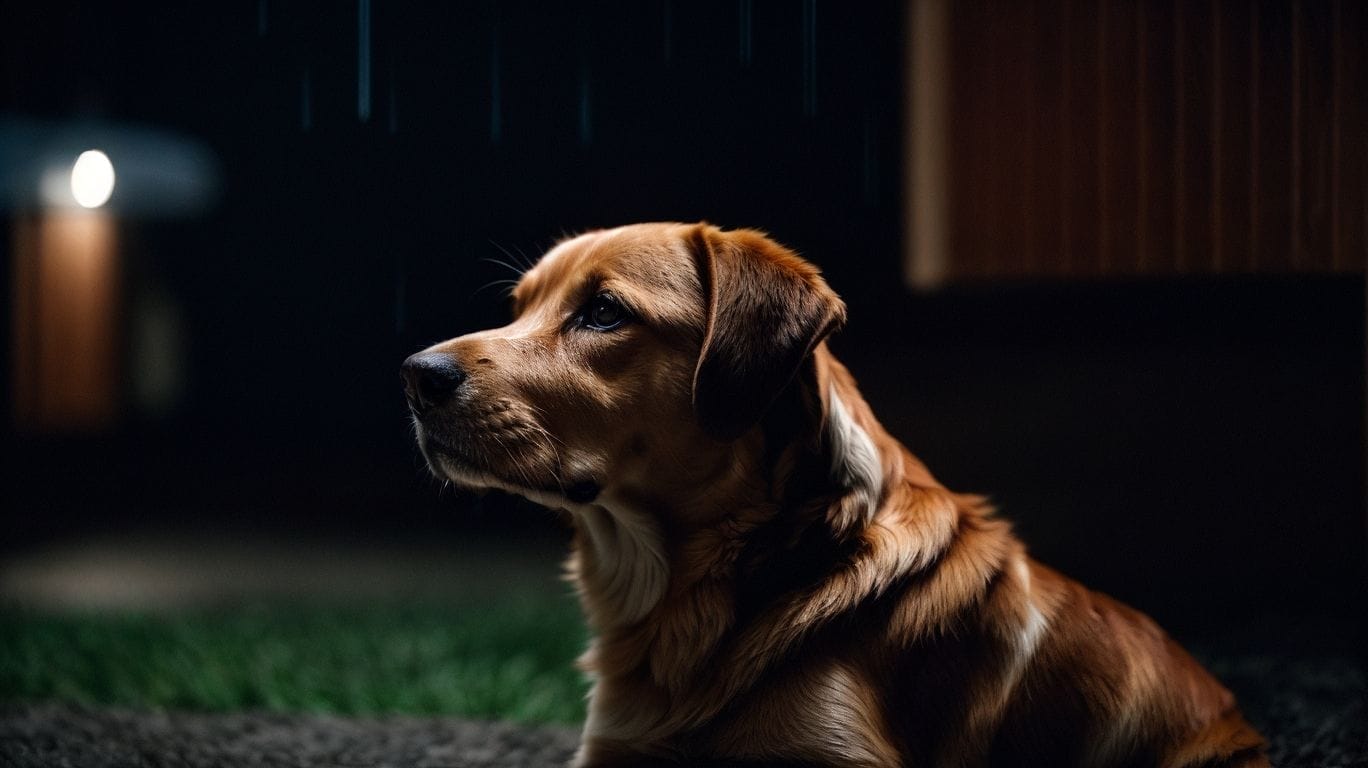
Photo Credits: Petnarnia.Com by Stephen Lee
When it comes to thunder phobia in dogs, several key causes can trigger their fear. From noise sensitivity to traumatic experiences and even a lack of exposure, these factors play a significant role in shaping a dog’s fear of thunder. In this section, we’ll explore each sub-section in detail, shedding light on the different reasons why our canine friends may find themselves cringing during a thunderstorm. So, let’s dive in and uncover the mysteries behind this common phobia!
1. Noise Sensitivity
Dogs can develop a fear of thunder due to their heightened sensitivity to loud sounds, otherwise known as noise sensitivity. This makes thunderstorms particularly distressing for them. Noise sensitivity in dogs can be a result of genetic factors or past traumatic experiences. Signs of noise sensitivity in dogs include shaking, excessive panting, hiding, destructive behavior, and barking. To help a dog scared of thunder, it is important to create a safe space for them, seek professional help if needed, and provide distractions and comfort. Training techniques such as desensitization and counterconditioning can also be effective. Early socialization, positive reinforcement training, and various calming techniques play a key role in preventing and managing noise sensitivity in dogs.
During ancient times, dogs were highly regarded for their exceptional hearing abilities. They were believed to possess a strong connection to the spirit world and were often seen as protectors against evil spirits and natural disasters, including thunderstorms. This belief was rooted in their innate noise sensitivity, which allowed them to detect approaching storms before humans could. In modern times, although our understanding of thunder has improved, dogs still retain their ancient role as guardians against the power of nature, reminding us of their remarkable noise sensitivity.
2. Traumatic Experience
Traumatic experiences can cause thunder phobia in dogs. A distressing event, such as being trapped in a thunderstorm or encountering a loud noise, can generate a long-lasting fear response. These occurrences can have a significant impact, particularly if they happen during a dog’s early developmental stages. Dogs might link the loud noise and fear response to the traumatic event, resulting in anxiety and phobia during subsequent thunderstorms. Recognizing this connection is crucial in assisting dogs in overcoming their fear of thunder. Techniques for modifying behavior, like desensitization and counterconditioning, can be utilized to help dogs establish positive associations with thunderstorms and diminish their fear response.
3. Lack of Exposure
Lack of exposure to thunder and loud noises during a dog’s critical socialization period can contribute to the development of thunder phobia. Here’s how you can help your dog overcome this fear:
- Gradual Exposure: Introduce your dog to the gentle sounds of thunder by playing recorded thunder sounds at a low volume, gradually increasing it over time.
- Positive Reinforcement: Reward your dog with treats and praise when they remain calm during exposure to thunder sounds.
- Desensitization: Gradually expose your dog to real-life thunder sounds in a controlled environment, ensuring they feel safe and comfortable.
- Be a Calming Presence: Provide comfort and reassurance to your dog during thunderstorms, offering soothing touches and creating a safe space.
Pro-tip: Consult with a professional dog trainer or behaviorist for personalized guidance in helping your dog overcome thunder phobia.
Lack of exposure to thunder and loud noises during a dog’s critical socialization period is a significant contributor to the development of thunder phobia. To assist your dog in conquering this fear, follow these steps:
- Gradual Exposure: Gradually increase the volume of recorded thunder sounds, starting at a low level, to introduce your dog to milder noises.
- Positive Reinforcement: When your dog remains calm while exposed to thunder sounds, reward them with treats and praise.
- Desensitization: In a controlled environment, gradually expose your dog to real-life thunder sounds, ensuring their safety and comfort.
- Be a Calming Presence: During thunderstorms, provide comfort and reassurance to your dog by offering soothing touches and creating a secure space.
Pro-tip: Seeking personalized guidance from a professional dog trainer or behaviorist can be helpful in assisting your dog in overcoming thunder phobia.
How to Help a Dog Scared of Thunder

Photo Credits: Petnarnia.Com by Henry Nguyen
If your furry friend trembles at the sound of thunder, don’t fret! In this section, we’ll explore how you can lend a helping hand to your scared pup. From creating a haven to seeking professional guidance, we’ll cover the techniques that can provide comfort and relief to your dog during thunderstorms. Get ready to discover practical tips and tricks that will help you ease your dog’s anxiety and ensure they feels secure when the thunder rolls.
1. Create a Safe Space
- In order to help a dog scared of thunder feel secure and comforted, it is crucial to create a safe space for them.
- Designate a quiet area in your home as a safe space for your dog, ensuring it is free from loud noises and distractions.
- Add cozy bedding, blankets, or familiar items that provide comfort to the safe space.
- To drown out the sound of thunder, use white noise or calming music.
- Please keep your dog occupied by providing them with interactive toys or puzzle feeders.
- Offer gentle words and pets to your dog, staying calm and reassuring to provide them with a sense of safety.
True story: My dog, Bailey, had a fear of thunderstorms. To help her cope, we created a safe space in a small room, filling it with her favorite toys and blankets and playing soft classical music. During storms, Bailey would immediately seek refuge in her safe space, finding comfort and peace until the storm passed. The simple act of creating a safe space made a significant difference in helping Bailey overcome her fear of thunder.
2. Seek Professional Help
- When it comes to managing a dog’s thunder phobia, seeking professional help is an essential step. It is crucial to consult with a professional dog behaviorist or trainer who can offer expert guidance and support in helping your dog conquer their fear.
- One of the initial steps to consider is researching reputable and qualified professionals who have experience in treating fear and anxiety in dogs. By doing so, you can ensure that you find the right person to assist you.
- After identifying potential professionals, it is important to schedule a consultation to discuss your dog’s specific needs and concerns. This will allow the professional to gain a better understanding of the situation and provide tailored advice.
- Following the advice and recommendations of the professional is imperative. They may suggest various training techniques, medication options, and behavior modification strategies that can assist in the process of overcoming your dog’s fear.
- Attending training sessions or behavioral consultations with your dog is another crucial aspect of seeking professional help. These sessions will focus on desensitization and counterconditioning techniques, which can help your dog gradually become accustomed to thunder and react more positively.
- Throughout the entire process, it is essential to remain consistent and patient. Overcoming a phobia takes time, and your dog may require time to conquer their fear of thunder fully.
By seeking professional help, you equip yourself with the necessary tools and guidance to address your dog’s thunder phobia effectively. Remember, expert assistance is invaluable in ensuring your dog’s well-being and helping them lead a happier, calmer life.
3. Provide Distractions and Comfort
When helping a dog scared of thunder, it is essential to provide distractions and comfort. Here are some tips for incorporating these keywords naturally:
| – Create a safe space: | Set up a cozy area with familiar items where your dog can feel secure during storms. This helps provide comfort. |
| – Use distractions: | Offer toys, treats, or puzzles to redirect their focus away from the sound of thunder. This helps provide distractions. |
| – Provide comfort: | Comfort your dog with gentle petting, soothing words, or physical contact to help them feel reassured. This helps provide both distractions and comfort. |
Remember, every dog is unique, so it may take some trial and error to find what works best. Fact: Offering a reassuring presence can significantly reduce a dog’s anxiety during thunderstorms.
Training Techniques to Manage Thunder Phobia
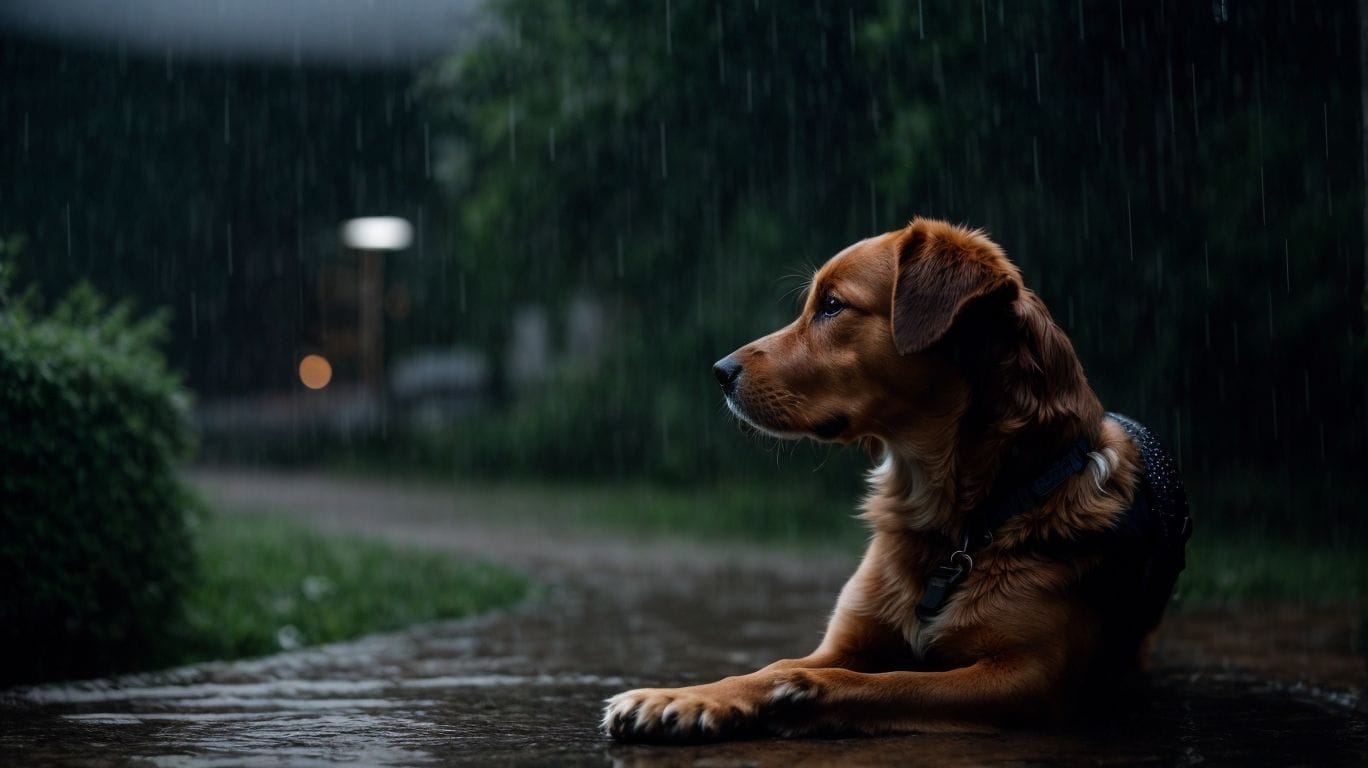
Photo Credits: Petnarnia.Com by Michael Martinez
Are you looking to help your furry friend overcome their fear of thunder? Dive into the world of training techniques for managing thunder phobia. From desensitization to counterconditioning and distraction techniques to medication options, we’ll explore a range of strategies to ease your dog’s anxiety during thunderstorms. Get ready to equip yourself with the tools and knowledge you need to support your pup in facing their fear head-on.
1. Desensitization
Desensitization is a technique frequently utilized to assist canines in conquering their fear of thunderstorms. It entails gradually exposing the dogs to the sound of thunder in a controlled environment. The process begins by playing thunder recordings at a low volume and progressively increasing it over time. The objective is to desensitize the dogs to the sound of thunder and diminish their anxious response through repeated exposure. It is crucial to conduct desensitization under the supervision of a professional dog trainer or behaviorist to ensure its safe and effective implementation. Patience and consistency are essential when utilizing this method.
2. Counterconditioning
- Counterconditioning is a powerful technique used to help dogs overcome their fear of thunder. It involves creating positive associations with thunder and gradually desensitizing them to the sound.
- Start by playing a recording of thunder at a very low volume while engaging the dog in activities they enjoy, such as playing with their favorite toy or receiving treats.
- Gradually increase the volume of the recording over several sessions, always pairing it with positive experiences for the dog.
- If the dog shows signs of fear or discomfort, reduce the volume or take a step back in the counterconditioning process.
- Consistently practice this technique and gradually expose the dog to louder and more realistic thunder sounds.
- It is important to be patient and consistent with counterconditioning, as it can take time. In severe cases, professional assistance may be required.
True story: I had a friend whose dog was terrified of thunderstorms. They started using counterconditioning to help their dog overcome the fear. By pairing the sound of thunder with treats and playtime, the dog slowly became more comfortable during storms. Over time, their fear diminished, and they were able to relax even during loud thunderstorms. Counterconditioning can be a powerful tool in helping dogs overcome their fears and live happier, more relaxed lives.
3. Distraction Techniques
Distraction Techniques can be helpful in managing a dog’s fear of thunder. Here are some steps to try:
Engage in interactive play with your dog using their favorite toys to redirect their attention.
Create positive associations by using treats or puzzle toys during thunderstorms to distract and occupy their mind.
Play calming music or white noise to help drown out the sound of thunder and provide a soothing atmosphere.
Provide a safe and comfortable hiding spot, such as a crate or a designated area, where your dog can retreat during storms.
Fact: Distraction Techniques can help alleviate anxiety in dogs by redirecting their focus and providing a sense of security.
4. Medication Options
When it comes to managing thunder phobia in dogs, medication options can be considered. These medication options provide a range of choices for addressing anxiety and fear during thunderstorms. Here are four medication options to explore:
- Anti-anxiety medications: These medications can effectively help dogs relax during thunderstorms, reducing their fear and panic.
- Phenobarbital or sedatives: Dogs can be calmed and experience a sense of tranquility through the use of these medications.
- Anti-depressants: For some dogs, anti-depressant medications may be beneficial in managing their anxiety and fear.
- Prescription tranquilizers: In severe cases of thunder phobia, stronger prescription tranquilizers may be recommended as an option.
Remember, it’s essential to consult with a veterinarian before starting any medication for your dog. They will be able to recommend the appropriate medication and dosage based on your dog’s specific needs.
Pro-tip: Along with medication, it’s also helpful to create a safe and comforting environment for your dog during thunderstorms by using soothing music, providing a cozy den, or using anxiety wraps.
Preventing Thunder Phobia
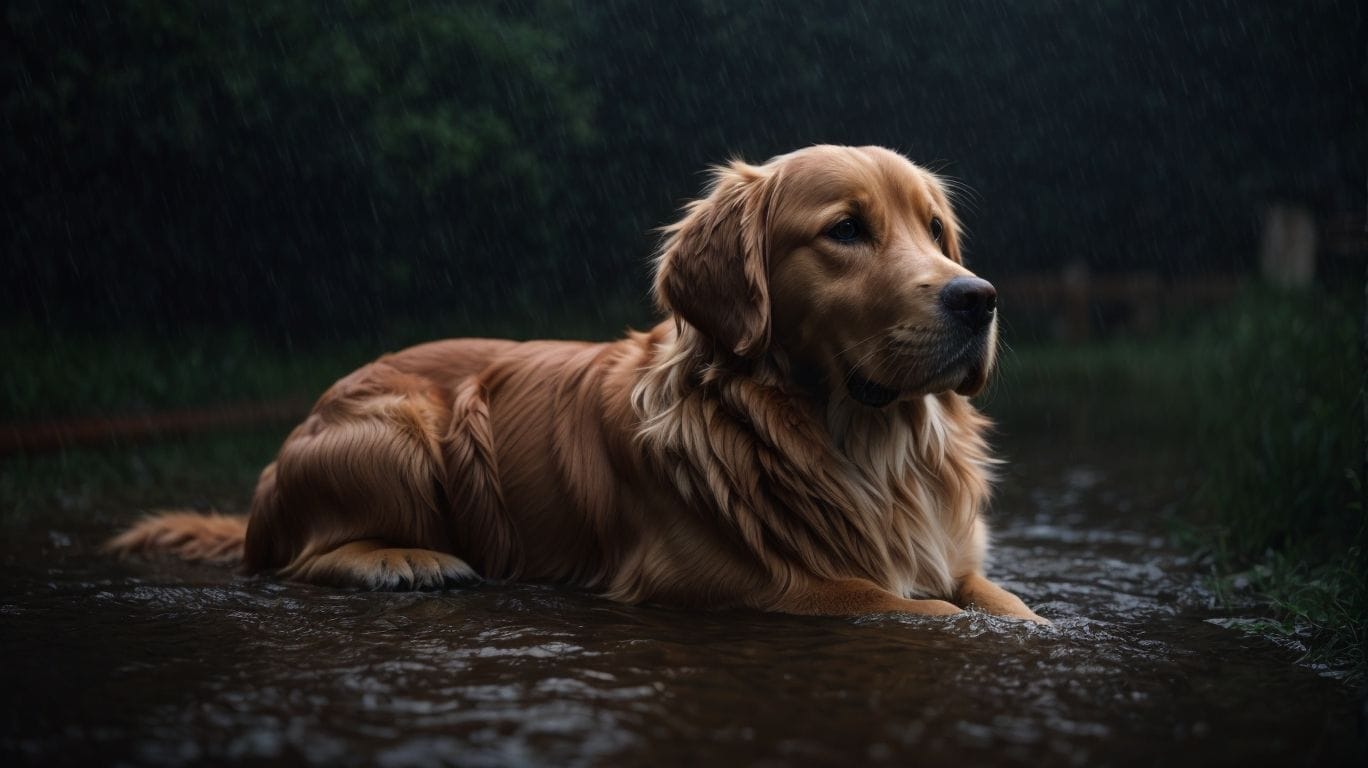
Photo Credits: Petnarnia.Com by Adam Nelson
Why wait for thunderstorms to strike fear in our furry companions when there are practical ways to prevent thunder phobia? In this section, we dive into effective strategies that can help dogs overcome their fear of thunder. From early socialization and exposure to positive reinforcement training and calming techniques, we’ll explore a variety of approaches that can make a substantial difference in alleviating this common canine anxiety. No more trembling paws or anxious barks – let’s empower our dogs to face storms with confidence.
1. Early Socialization and Exposure
Early socialization and exposure play a vital role in preventing thunder phobia in dogs. It is important to introduce your puppy to a variety of sights, sounds, and experiences during their critical socialization period, which usually occurs between the ages of 3 and 14 weeks. Gradually exposing them to different sounds, including recordings of thunder, in a controlled and positive manner is beneficial. To create positive associations, make sure to reward your dog with treats, play, and praise during these exposures. This approach helps them in developing confidence and resilience to loud noises such as thunderstorms. It is crucial to remember that early socialization and exposure are the key factors in nurturing a well-adjusted and fearless canine companion.
Fun fact: Dogs possess incredible learning abilities and adaptability. With proper socialization practices, they can develop a more positive response to thunder and other loud noises.
2. Positive Reinforcement Training
Positive reinforcement training is an effective approach to help dogs manage their fear of thunder. Here is a list of steps to incorporate this technique:
- Start by identifying triggers and gauging the dog’s reaction to thunder.
- Implement positive reinforcement training methods like treats, praise, and rewards to create positive associations with thunder.
- Gradually expose the dog to low-intensity thunder sounds and reward calm behavior.
- Gradually increase the volume of the thunder sounds while rewarding the dog for remaining relaxed.
- Continue the training sessions, gradually exposing the dog to louder and more realistic thunder sounds.
Remember, consistency, patience, and rewarding desired behaviors are key. Consistent positive reinforcement training will help your dog develop positive associations with thunder, reducing their fear and anxiety.
3. Calming Techniques
- When helping a dog scared of thunder, 3 calming techniques can be effective in reducing their anxiety.
- Creating a safe space for your dog, such as a cozy den or a designated area where they feel secure, is one of these calming techniques.
- Using calming aids, such as calming music or a ThunderShirt, is another one of these calming techniques that applies gentle pressure to help alleviate anxiety.
- Providing distractions and comfort, such as giving them a toy or treat to focus on or cuddling with them to provide reassurance, is also one of these calming techniques.
- Using aromatherapy with calming scents, like lavender or chamomile, which can have a soothing effect on dogs, is a calming technique.
- Implementing relaxation techniques, such as deep breathing exercises or massage, to help your dog relax during thunderstorms is one of these calming techniques.
By incorporating these 3 calming techniques, you can help your dog feel more secure and reduce their fear of thunder.
Some Facts About Why Dogs Are Scared of Thunder:
- ✅ Dogs can get stressed during thunderstorms, with some showing mild signs of stress and others becoming destructive. (Source: AKC)
- ✅ Dogs hate thunderstorms because of the loud sounds and their sensitivity to changes in air pressure and static electricity. (Source: AKC)
- ✅ Tips for soothing dogs during thunderstorms include giving them a safe space, providing background noise, and using toys and treats to distract and calm them. (Source: AKC)
- ✅ Dogs often hate thunderstorms because of the uncomfortable feeling of static electricity, not just the noise. (Source: The Dodo)
- ✅ Socializing a dog at a young age can help reduce the chances of them developing anxiety towards thunderstorms. (Source: The Dodo)
